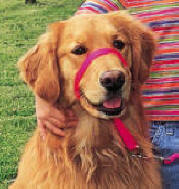
Click on
Library Icon
to learn more
|
Neck collars
Some neck collars are actually dangerous. Slip
collars (chain or other material) when used
incorrectly can be "an instrument of asphyxiation."
Sharp prong collars can not only puncture skin
causing abscesses, but like shock collars, can
 cause
the dog to redirect aggression onto the closest
person – you. cause
the dog to redirect aggression onto the closest
person – you.
For most dogs, nylon collars are recommended.
A snap-together (sometimes known as a, "seat-belt"
or "pinch-release") buckle is better than the
prong-in-hole type because the adjustments of the
former are not limited by the punched holes. The
correct fit for a collar is one that cannot
slide over the dog's head, but otherwise is as loose
as possible.
|
.jpg)
Premier®
Martingale collar |
In
addition to more accurate fit, nylon snap collars
offer additional advantages. They can be decorative,
washed, and last for a long time. Check the
fit frequently on a growing dog. If your dog's head
is still able to slip off the neck collar, a
martingale collar, such as a Premier® collar, will
prevent the dog from slipping out of its collar.
|
Head
collars are recommended for
virtually all dogs, but
especially for dogs that
weigh over 40 pounds that
are hyperactive, aggressive,
or pull on the leash. |
 Head
collars Head
collars
The newest
style of dog collars are called head collars or head
halters. This style is fashioned after the horse
halter. The advantage of a head collar is that it
pulls the head from side to side but does not choke
the neck. Head halters are a humane and safe way of
signaling dogs to turn in a particular direction or
to stop. Commercial brand names include the Gentle
Leader® Head collar or Halti®.
Leashes
The most commonly recommended leash is a nylon or
leather four or six-foot.jpg) lead. Ironically, the smaller the dog, the longer
the lead. This is because a tiny dog's neck is
further away. More sensibly, the smaller the
dog the thinner the lead.
lead. Ironically, the smaller the dog, the longer
the lead. This is because a tiny dog's neck is
further away. More sensibly, the smaller the
dog the thinner the lead.
With nylon leashes it can be fun to match the color
of the collar and leash to be "styling."
Leather is more expensive than nylon and can dry out
if repeatedly soaked in water. Some dogs who
chew leather may target the leash if left available.
Many dogs try to chew on their leash regardless of
material. Don't allow even a second of this.
If observed, give a verbal short sharp interruption
like "At!" and use your hands to pull the leash out
of the dog's mouth. Then either get moving,
redirect into a chew toy, or otherwise be sure this
does not develop into a habit.
The snap should not be so large it hits the dog
under the chin. If your dog pulls, brace yourself,
bring the leash to the center of your body and
prevent being pulled over. If the dog pulls,
just stop walking and insist the dog sit and calm
down before any further forward progress.
Chain leashes are not recommended for walking
because they catch the dog's hair and nails, often
pulling them out. They are also difficult to hold
onto, noisy, heavy, and can slap the dog in the
face. However, a chain leash can function well as a
tether when doing the Close Tethering technique.
The chain cannot be chewed through when you have
turned your head.
Retractable leashes
Retractable leashes retain control, yet allow a much
wider leash range on a walk. This increased range
allows the dog to run ahead and sniff at one spot as
you continue walking. Soon the dog is passed and
left behind, still happily sniffing. The dog can
then run and catch up without you having to stop
your walk for dog sniffing.
Because the retractable cord stays taut, if used
correctly it will not tangle around the dog's legs.
Practice using a retractable leash in your yard
prior to taking the dog out on the sidewalk because
it requires some skill to handle safely.
Make
sure you know how to stop the leash and retract it
when approaching traffic, people and other animals.
If your dog has any tendency to dart into traffic,
be especially vigilant.
|
There are some disadvantages to retractable leashes.
If the dog suddenly takes off and hits the end, a
retractable leash can jerk or yank at a head or neck
collar, which has the potential to
cause neck damage. Therefore, if the dog
begins running, swing the handle away from the dog
and lock it. Then when the dog hits the end,
instead of a sudden jolt, your arm is swung forward
which cushions the stop.
Except in severe pulling cases, it is not
recommended to use both a head collar and a
retractable leash at the same time. Because a
retractable leash maintains constant tension, this
will likely confuse a dog wearing a head collar
because it is the release of tension on the leash
that is a reward for walking without pulling.
Retractable leashes require the person walking the
dog to pay closer attention to the dog so that he or
she does not get too far away, wander into a road or
become tangled around an object. A retractable
leash does not deter pulling. If your dog is
difficult to control, this tool is best used after
your dog has been trained to walk on a fixed length
leash.
There are two types of retractable leashes. The
shorter length leashes (16') usually use a flat tape
that looks much like a regular nylon leash, but
longer. The 26' leashes are mostly thin round nylon
cord. These extra long retractable leashes
should not be used around children because the thin
nylon lead can cut through skin if the dog moves
suddenly. If not careful, deep cuts, burns,
eye injuries or even amputations can result.
However, if used carefully many dogs and people use
them safely on their daily walks.
|